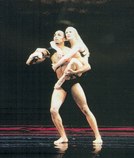|
 |
|
|
 |
 |
About the Author:
 Dankmeyer Dance CompanyAn Evening of New Choreography by Erica Dankmeyer Prelude—fallen: Ocean (1998): Fire in the Mind (Premier): Amanda's Solo (Premier): Likings for Shadows (2001): The Distance Within (Premier): Tree Line (Premier). Review by Dr. Roberta E. Zlokower September 5, 2002, St. Mark's Church in-the-Bowery
Erica Dankmeyer (edankmeyer@earthlink.net), Artistic Director, Dancer, Choreographer, and Teacher, began her ballet training with Paul Curtis and Anna Bena in California. She studied Modern and African dance at Williams College, where she returns annually as Guest Artist. Ms. Dankmeyer has been a member of the Martha Graham Dance Company since 1996, has performed in many Graham ballets, such as the Woman in Yellow in Diversion of Angels. Ms. Dankmeyer has choreographed works for herself and for members of the Graham Company and Ensemble, which have been presented around the United States. Ms. Dankmeyer is on the faculty of the Martha Graham School and has taught at the Neighborhood Playhouse School of Theater, Williams College, and Marymount Manhattan College. Prelude - fallen: Conceived and performed by Andrea Haenggi. "Inspired by my visit to Istanbul, this repeated ritual-prayer lasts just long enough to support one breath." The dancer crawls on the rear edge of the dance space, with Graham-like elongations, as the audience is seated. Ocean: Choreography by Erica Dankmeyer, performed by Erica Dankmeyer and Martin Lofsnes, music by Dead Can Dance. Ms. Dankmeyer crawls over and through Mr. Lofsnes' legs, leaps onto his shoulders, and presents percussive writhing in snake-like fashion. The electronic music undulates like ocean waves, as the dancers switch roles, both in black leotards with red stripes, with the female dragging the male in a give and take of weight and balance, which is ever present in all Ms. Dankmeyer's dances. Fire in the Mind: Choreography by Erica Dankmeyer, performed by Alessandra Prosperi, music arranged and performed by Motomi Igarashi. Ever-changing light patterns were apparent throughout all of the dances. The St. Mark's Church space is cavernous and stark white, with the audience seated around one end of the space, on a platform above the aisles, so dancers pass in close proximity. Ms. Igarashi played the Viola Da Gamba, a beautifully curved and sensual instrument, the size of a cello. Ms. Prosperi maximized a lengthy roll of natural material to roll over and around herself, as one in a mourning shroud, or as a mummy. The mood was mystical and evocative of a primitive emotion. Amanda's Solo: Choreographed and performed by Deborah Zall, music by Stephen Weinstock. Deborah Zall, a student of Martha Graham herself, is known for her solo portrayals of women, and several renowned choreographers have reconstructed solo works for her. With effective props in small and large mirrors, Ms. Zall, who dances and bears a striking resemblance to Martha Graham, appears to dance with arms outreached to heaven, as she gazes from mirror to mirror, perhaps visually bonding with her emotions, perhaps seeking signs of her youthful persona. Ms. Zall makes full use of the Graham techniques of contraction and release of the upper torso. She dances with grace, with class, evocative of Martha Graham and Ruth St. Denis. Likings for Shadows: Choreography by Erica Dankmeyer, performed by Elizabeth Auclair, Alessandra Prosperi, and Erica Dankmeyer, music by Stephen Smith. To percussive rhythms with African overtones, the dancers clap hands onto their arms, in unison and in solo, swaying like trees joined in the forest. They divide from the roots, one spinning toward center stage, and the others branching to the farther reaches of the dance space. The central concept in all the Dankmeyer dances seems to revolve around balance and shifting of weight, roles, strength, emotion, and sexuality. The Distance Within: Choreography by Erica Dankmeyer, performed by Martin Lofsnes, song and text written and performed by Morley. Performing what seems to be a wailing gospel, with phrases, such as, "…carried the weight of it all"; Morley imbues the stage with a stark ambiance, while Mr. Lofsnes stands suspended on one leg. He dances with high drama and extended legs and torso, close spins and concentration on self. Tree Line: Choreography by Erica Dankmeyer, performed by Elizabeth Auclair, Erica Dankmeyer, Christophe Jeannot, Martin Lofsnes, Alessandra Prosperi, and Yuko Suzuki, music by John Williams. Using the full atrium of St. Mark's Church in-the-Bowery, with a tree form suspended, and with dim light, like dawn awakening, five separate dances are performed, in chiffon over leotards. The elegant choreography, with precise footwork, is set to staccato rhythms of strings and percussion. Without an apparent theme, these dances are a visual selection of delicacies, of connections and interconnections. With visceral images of veins painted on the leotards, Ms. Dankmeyer creates costumed and choreographic surprises. Ms. Dankmeyer's apparent specialty, of designing forms of dance that shift weight and strength from partner to partner, or from one partner to a group of partners, with various balancing effects of leverage and lifts, is quite amazing. One figure, Christophe Jeannot, who possesses unusual flexibility, creates the illusion of Nijinsky in L'Apres Midi d'un Faune. The faun in erotically charged, contract-release movements slithers on the stage floor, although this was not the shocked Paris audience of the 1920's. Other male dancers evoked images of deer, locking horns, shifting weight, with driving energy and interlocking bodies, with what would appear to be the weaker of the two, carrying off the stronger one. The duos and trios wind under, over, and through each other with momentary joining and separations, in physically engaging and energetic feats. Photos courtesy of Erica Dankmeyer 

|
|
|




